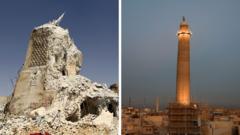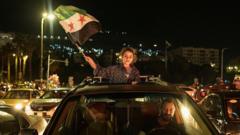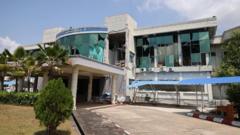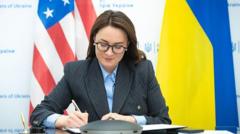After enduring the horrific ravages of the Islamic State's occupation, Mosul is witnessing a revival of its cultural landmarks, spearheaded by UNESCO's restoration initiatives. With community collaboration and renewed hope, the city's historic buildings and long-standing traditions are being restored, signaling a brighter future for its residents.
Mosul’s Restoration: A Beacon of Hope After Years of Destruction

Mosul’s Restoration: A Beacon of Hope After Years of Destruction
The landmark city of Mosul is slowly reclaiming its historic identity as UNESCO leads extensive restoration efforts following years of devastation by the Islamic State.
In the aftermath of the Islamic State's brutal domination, historic Mosul is slowly finding its way back to cultural prominence as efforts to restore its devastated architectural heritage gain momentum. The initiative, funded and organized by UNESCO, commenced shortly after IS was ousted from the city in 2017, marking a significant turning point for a community long known for its religious diversity.
UNESCO's Director-General, Audrey Azoulay, is set to attend a reopening ceremony that will not only honor the renovated sites but also bring together artisans, local residents, and representatives from various religious backgrounds within Mosul. The bleak shadows of IS's rule, which began in 2014, still linger in the minds of the city's inhabitants, but this revival aims to rekindle the spirit of coexistence that Mosul was once celebrated for.
The intensification of violence during the battle to liberate Mosul culminated in the destruction of a staggering 80% of the city's Old Quarter—a potent symbol of its rich history. Most infamously, the al-Nuri mosque’s iconic leaning al-Hadba minaret was demolished, an event captured in the haunting memories of local photographer Ali al-Baroodi. “It was like a ghost town,” he described the devastation, recounting the eeriness felt post-liberation.
UNESCO's reconstruction project, which has gathered $115 million primarily from the UAE and the EU, aims not only to restore physical structures like the revered al-Saa'a Convent and various places of worship but also to revive community trust shattered by violence. As Dominican priest Father Olivier Poquillon articulates, “Rebuilding trust is essential; without it, the stone walls will become targets once more.”
Maria Rita Acetoso, the chief architect leading the restoration, emphasizes that cultural revival can offer economic opportunities and allow the community to reclaim its identity. Her efforts have successfully mobilized local youth, equipping over 1,300 with traditional skills and generating 6,000 new jobs, with a notable emphasis on female participation in the rebuilding workforce.
As landmarks like al-Tahera Church and the iconic al-Hadba minaret reclaim their places in Mosul's skyline, residents are expressing joy at returning to their historic homes. One resident shared the emotional weight of seeing his family home, built in 1864, restored. “I thought I would never be able to come back,” he reflected, reveling in the memories tied to the now rebuilt walls.
While the scars of conflict remain deeply entrenched within Mosul's landscapes and hearts, the ongoing reconstruction represents a resilient stride towards healing. Ali al-Baroodi poignantly observes, “It’s like seeing a dead person coming back to life,” highlighting the city’s transformative journey from ruin to revival. The hope that emanates from Mosul’s streets serves as a reminder of the unbreakable spirit of its people, steadfast amidst the shadows of their past.
UNESCO's Director-General, Audrey Azoulay, is set to attend a reopening ceremony that will not only honor the renovated sites but also bring together artisans, local residents, and representatives from various religious backgrounds within Mosul. The bleak shadows of IS's rule, which began in 2014, still linger in the minds of the city's inhabitants, but this revival aims to rekindle the spirit of coexistence that Mosul was once celebrated for.
The intensification of violence during the battle to liberate Mosul culminated in the destruction of a staggering 80% of the city's Old Quarter—a potent symbol of its rich history. Most infamously, the al-Nuri mosque’s iconic leaning al-Hadba minaret was demolished, an event captured in the haunting memories of local photographer Ali al-Baroodi. “It was like a ghost town,” he described the devastation, recounting the eeriness felt post-liberation.
UNESCO's reconstruction project, which has gathered $115 million primarily from the UAE and the EU, aims not only to restore physical structures like the revered al-Saa'a Convent and various places of worship but also to revive community trust shattered by violence. As Dominican priest Father Olivier Poquillon articulates, “Rebuilding trust is essential; without it, the stone walls will become targets once more.”
Maria Rita Acetoso, the chief architect leading the restoration, emphasizes that cultural revival can offer economic opportunities and allow the community to reclaim its identity. Her efforts have successfully mobilized local youth, equipping over 1,300 with traditional skills and generating 6,000 new jobs, with a notable emphasis on female participation in the rebuilding workforce.
As landmarks like al-Tahera Church and the iconic al-Hadba minaret reclaim their places in Mosul's skyline, residents are expressing joy at returning to their historic homes. One resident shared the emotional weight of seeing his family home, built in 1864, restored. “I thought I would never be able to come back,” he reflected, reveling in the memories tied to the now rebuilt walls.
While the scars of conflict remain deeply entrenched within Mosul's landscapes and hearts, the ongoing reconstruction represents a resilient stride towards healing. Ali al-Baroodi poignantly observes, “It’s like seeing a dead person coming back to life,” highlighting the city’s transformative journey from ruin to revival. The hope that emanates from Mosul’s streets serves as a reminder of the unbreakable spirit of its people, steadfast amidst the shadows of their past.



















